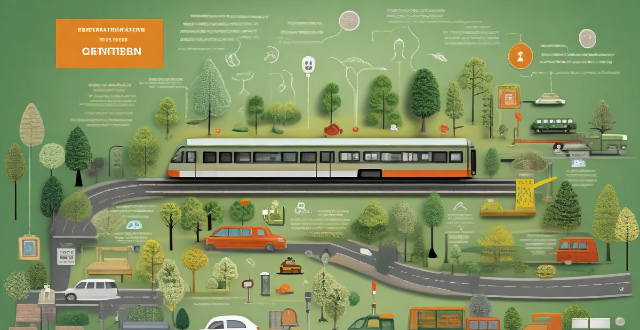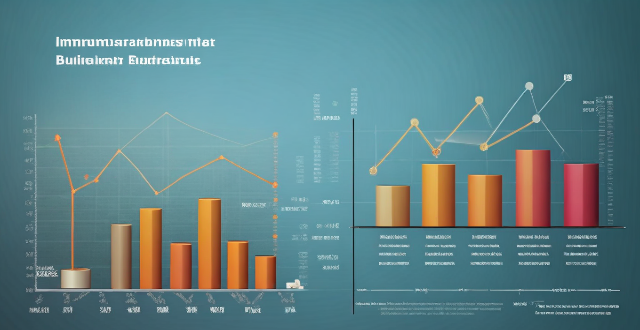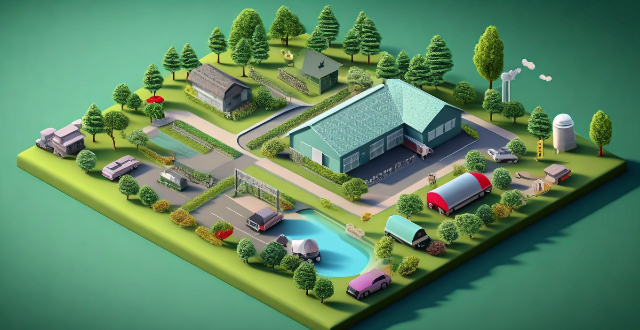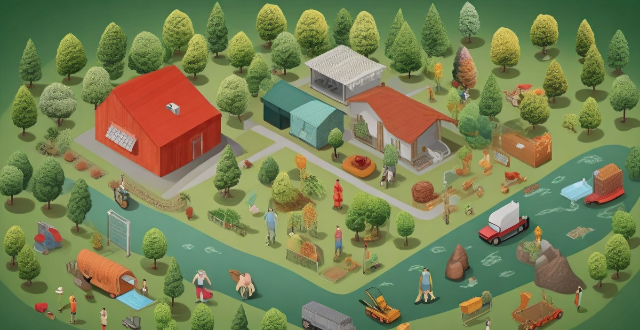Individual Footprint

What is a carbon footprint calculator and how does it work ?
A carbon footprint calculator is a tool that helps individuals, businesses, and organizations estimate their greenhouse gas emissions. It calculates the amount of CO2 and other greenhouse gases released into the atmosphere due to various activities such as driving, flying, using electricity, and consuming goods and services. The calculator collects data on these activities, applies emission factors based on scientific studies, adds up the emissions, and presents results along with recommendations for reducing the carbon footprint. Examples of carbon footprint calculators include individual, business, and product calculators. Using these tools can help individuals and organizations understand their environmental impact and take action to reduce it.

What role does renewable energy play in reducing carbon footprint ?
Renewable energy is crucial in reducing carbon footprint as it is obtained from natural resources and does not emit harmful greenhouse gases. It benefits the environment, economy, and society by mitigating climate change, reducing dependence on imported fuels, and providing affordable energy to remote areas. Solar, wind, hydro, geothermal, and biomass energy are types of renewable energy sources. However, challenges such as cost, intermittency, storage, and grid integration need to be addressed. Continued investment and innovation can make renewable energy more accessible and affordable for everyone.

How can education contribute to reducing carbon footprint ?
Education plays a pivotal role in promoting environmental sustainability by raising awareness, encouraging sustainable practices, and empowering future leaders. It can contribute to reducing carbon footprints through curriculum integration, real-world examples, interdisciplinary projects, community outreach, media campaigns, partnership with NGOs, implementing green initiatives in schools, teaching practical skills, developing critical thinking, nurturing eco-advocacy, and preparing students for careers in environmental policy making. By focusing on these aspects, education can significantly contribute to reducing carbon footprints and paving the way for a more sustainable future.

What is a carbon footprint ?
A carbon footprint is a measure of the impact on the environment in terms of greenhouse gases produced. It includes direct and indirect emissions from activities like driving, electricity consumption, and food production. Reducing one's carbon footprint is crucial for combating climate change and promoting sustainability. Ways to do so include using public transit, energy-efficient appliances, eating locally grown food, and proper waste management.

How does reducing carbon footprint impact climate change ?
Reducing our carbon footprint is essential to mitigate climate change. It involves decreasing greenhouse gas emissions from activities like energy use and transportation. Direct effects include reduced fossil fuel consumption, improved energy efficiency, and increased carbon sinks through afforestation. Indirectly, it influences policy, drives economic changes, and promotes social awareness. Overall, reducing the carbon footprint leads to a sustainable culture, slowing down climate change.

How does transportation affect our carbon footprint ?
Transportation's Impact on Our Carbon Footprint explores how different modes of transportation contribute to greenhouse gas emissions. It highlights the significance of air travel and cars as major sources of CO2 emissions, while also discussing the benefits of public transit, cycling, and walking. The text emphasizes the importance of vehicle efficiency, alternative fuels, and urban planning in reducing carbon footprint. It suggests strategies such as reducing air travel, driving less, choosing efficient vehicles, and supporting green infrastructure to mitigate transportation's impact on the environment.

Why is it important to use a carbon footprint calculator for individuals and businesses ?
The importance of using a carbon footprint calculator is highlighted for individuals and businesses. For individuals, it helps in understanding personal impact, raising awareness, motivating behavior change, setting goals, and contributing to global efforts. For businesses, it aids in corporate responsibility, cost savings, compliance and reporting, enhancing brand image, stakeholder engagement, risk management, and innovation. Using a calculator empowers both to make informed decisions for a sustainable future.

Can team sports contribute to mental rejuvenation more than individual sports ?
Team sports may contribute more to mental rejuvenation than individual sports due to increased social interaction, motivation, and sense of belonging. However, individual preferences vary, and some people may find greater mental rejuvenation through individual sports or other activities that bring them joy and fulfillment.

Can individual actions significantly contribute to addressing climate change from an ethical standpoint ?
From an ethical standpoint, individual actions can significantly contribute to addressing climate change. This is because every individual has a responsibility to take care of the environment and protect it for future generations. Here are some ways in which individual actions can make a difference: - Reducing Carbon Footprint: One of the most effective ways to address climate change is by reducing our carbon footprint. This can be done by making small changes in our daily lives, such as using public transportation or carpooling instead of driving alone, turning off lights and electronics when not in use, eating less meat and more plant-based foods, and buying products with less packaging and recycling whenever possible. By making these changes, we can reduce our carbon emissions and help slow down the effects of climate change. - Supporting Renewable Energy: Another way individuals can contribute to addressing climate change is by supporting renewable energy sources. This can be done by installing solar panels or wind turbines on your property (if feasible), switching to a green energy provider that uses renewable energy sources, and encouraging your local government to invest in renewable energy projects. By supporting renewable energy, we can reduce our reliance on fossil fuels and help transition to a cleaner, more sustainable energy system. - Educating Others: Finally, one of the most important things individuals can do to address climate change is to educate others about its severity and urgency. This can be done by sharing information about climate change with friends and family, attending protests or rallies to raise awareness about the issue, and writing letters to elected officials urging them to take action on climate change. By educating others, we can spread awareness about the issue and encourage more people to take action to address it.

How can team sports help in individual skill development ?
Team sports contribute significantly to individual skill development by improving communication skills, enhancing leadership abilities, increasing self-confidence, bettering time management, improving social skills, promoting physical fitness and coordination, providing opportunities to learn from mistakes, and fostering adaptability.

How does team sports impact mental health compared to individual sports ?
This article explores how team sports impact mental health compared to individual sports. It highlights the social support and belongingness provided by team sports, which can reduce feelings of isolation and loneliness. The article also discusses how team sports promote accountability and responsibility, helping individuals develop discipline and self-control. Additionally, it emphasizes the importance of goal setting and achievement in team sports, which can boost self-esteem and confidence. Overall, the article concludes that team sports have a significant impact on mental health compared to individual sports due to their social aspect.

How do individual versus team sports impact self-esteem in young people ?
The text discusses the impact of individual versus team sports on self-esteem in young people. It outlines key points such as the focus on personal growth and discipline in individual sports, and the social support and collaboration learned in team sports. The benefits of each type of sport are also highlighted, including increased autonomy and clear feedback from individual sports, and social skills development and resilience from team sports. A comparative analysis is provided, discussing the pros and cons of each type of sport in relation to self-esteem. The conclusion suggests that both types of sports can positively impact self-esteem, but finding the right fit for each individual is crucial.

Is there a difference in mental health benefits between individual and group exercises ?
Exercise plays a vital role in maintaining good mental health, with both individual and group exercises offering unique benefits. Individual exercises provide flexibility, focus, and personal challenge, while group exercises offer social support, motivation, and accountability. Both types of exercise have been shown to reduce stress, anxiety, and depression while improving mood, self-esteem, and cognitive function. Ultimately, finding an activity that you enjoy and can consistently incorporate into your lifestyle is key to maintaining good mental health through exercise.

How do individual versus team sports differ in their impact on child development ?
Individual sports foster self-reliance and technical mastery, while team sports emphasize social skills and emotional intelligence. Both have unique benefits for child development, and the choice should consider the child's personality and desired skill development. A combination of both might provide the most well-rounded experience.

How do energy-efficient buildings reduce carbon footprint ?
Energy-efficient buildings are crucial for reducing carbon footprint by minimizing energy use and optimizing resources. They incorporate features like proper insulation, air tightness, advanced HVAC systems, renewable energy sources, and smart technology to reduce energy consumption, lower greenhouse gas emissions, and mitigate climate change impact. These structures offer benefits such as lower utility bills, increased comfort, reduced maintenance costs, and higher resale value. Energy-efficient buildings play a significant role in combating climate change and promoting a sustainable future.

How do the principles of sports biomechanics differ between individual and team sports ?
This text discusses the principles of sports biomechanics in individual and team sports. It highlights the differences in kinematics, kinetics, and coordination between the two types of sports. In individual sports, there is a focus on precision, technique optimization, and personal performance, while team sports emphasize strategic interactions, group coordination, and adaptability to complex game situations. The text concludes by emphasizing the importance of understanding these distinctions for coaches and athletes to tailor their training approaches to best suit the specific demands of their chosen sport.

How accurate are the results from a carbon footprint calculator ?
The accuracy of carbon footprint calculators can vary based on data sources, scope of calculation, user input, and methodology. Limitations include generalizations and lack of standardization. Despite these limitations, using reputable sources and understanding the scope can help users interpret results accurately. The goal is to raise awareness and encourage reductions in carbon emissions.

How can individuals reduce their carbon footprint ?
Reducing your carbon footprint is crucial for mitigating climate change. Individuals can contribute by adopting practices in transportation, home energy use, food consumption, waste management, water conservation, shopping habits, and advocacy and education. These include using public transport or electric vehicles, walking or cycling short distances, using energy-efficient appliances, insulating homes, eating plant-based diets, buying local and reducing food waste, recycling and composting, fixing leaks, supporting sustainable policies, and educating others.

In what ways are consumers reducing their carbon footprint through their purchasing decisions ?
Consumers are reducing their carbon footprint by choosing sustainable products, reducing waste, considering energy efficiency, making eco-friendly transportation choices, supporting green companies, and digitally decarbonizing. These actions not only lessen individual environmental impact but also encourage businesses to adopt more sustainable practices, contributing to a broader effort against climate change.

What is the role of individuals in addressing climate change and environmental degradation ?
This article discusses the role of individuals in combating climate change and environmental degradation. It highlights the cumulative impact of individual actions, their potential to inspire others, and the political pressure they can exert. The article provides practical steps individuals can take, such as reducing their carbon footprint, supporting renewable energy, waste reduction and recycling, advocating for environmental policies, and spreading awareness. It emphasizes that collective efforts can make a significant difference in creating a more sustainable future for our planet.

Are there any drawbacks or limitations to using a carbon footprint calculator ?
The text discusses the drawbacks and limitations of using carbon footprint calculators. These include issues with data accuracy, scope of coverage, user bias, lack of personalization, generalization, complexity, motivation, and cost. While these calculators can be helpful in reducing environmental impact, it is important to recognize their limitations and make informed decisions about their use.

What are the legal obligations for companies regarding their carbon footprint ?
Companies face various legal obligations concerning their carbon footprint aimed at reducing greenhouse gas emissions and mitigating climate change. These include mandatory and voluntary emissions reporting, regulatory compliance through emissions caps and permitting, corporate governance measures like board oversight and stakeholder engagement, financial responsibilities such as carbon taxes and trading schemes, commitments under international agreements, and potential civil liabilities for negligence or human rights violations related to pollution. Companies must take proactive steps to reduce emissions, engage stakeholders, and contribute positively to global climate action, with specific requirements depending on the jurisdiction, industry, and individual company's commitments.

How can individuals reduce their carbon footprint in their daily life ?
Individuals can reduce their carbon footprint by adopting eco-friendly habits in transportation, home energy use, consumption habits, dietary choices, and advocacy. They can opt for public transit, carpooling, cycling, walking, or electric vehicles; use energy-efficient appliances, LED bulbs, and adjust thermostat settings; reduce, reuse, recycle items, support eco-friendly brands, buy local produce, and conserve water; incorporate plant-based meals, reduce food waste, and compost scraps; educate others and support green initiatives.

How can businesses adopt sustainable energy practices to reduce their carbon footprint ?
Businesses can adopt sustainable energy practices to reduce their carbon footprint by switching to renewable energy sources, improving energy efficiency, implementing energy management systems, promoting green commuting, using environmentally friendly materials and processes, and educating stakeholders. These strategies not only benefit the environment but also enhance a company's reputation and can lead to cost savings in the long run.

How can individual athletes contribute to environmental conservation efforts through their lifestyle choices ?
Individual athletes can contribute to environmental conservation through eco-friendly habits and sustainable practices, such as reducing energy consumption, making conscious transportation choices, adopting a sustainable diet, conserving water, reducing waste, and engaging in advocacy and education. These actions not only help the planet but also inspire others to follow their lead, creating a ripple effect of positive change for the environment.

How can I calculate my personal carbon footprint ?
This article provides a detailed guide on how to calculate your personal carbon footprint, which is the total amount of greenhouse gases released into the atmosphere as a result of your activities. It explains what a carbon footprint is, the importance of calculating it, and the steps involved in doing so. The steps include gathering information about your lifestyle habits, using online carbon footprint calculators, breaking down your emissions by category, identifying areas for improvement, setting goals, and tracking progress. The article emphasizes that taking action to reduce your carbon footprint is crucial for a healthier planet.

What are the environmental benefits of using a CHEV ?
The text discusses the environmental benefits of using a CHEV (Compound Hybrid Electric Vehicle), which includes reduced greenhouse gas emissions, improved fuel efficiency, lower carbon footprint, conservation of natural resources, and reduced noise pollution. CHEVs combine the powertrains of an internal combustion engine and an electric motor, resulting in fewer emissions and lower fuel consumption compared to traditional gasoline-powered vehicles. They also have regenerative braking systems that capture energy from braking and convert it into electricity for storage in the battery, further improving their overall fuel efficiency. By choosing a CHEV over a conventional vehicle, individuals can reduce their personal carbon footprint and help mitigate the effects of climate change.

What actions can I take to offset the carbon footprint calculated by the calculator ?
This article provides a comprehensive guide on how individuals can offset their carbon footprint through various actions. These actions include reducing energy consumption, using public transportation or carpooling, reducing waste, eating a plant-based diet, and supporting renewable energy. Each section offers specific tips and strategies that readers can implement in their daily lives to reduce their GHG emissions. By following these steps, individuals can contribute to mitigating climate change and promoting a more sustainable future.

What are the benefits of reducing carbon footprint ?
The benefits of reducing carbon footprint include mitigating climate change by lowering greenhouse gas emissions, preserving natural resources and biodiversity, improving air and water quality, saving money on energy bills, creating jobs in the renewable energy sector, enhancing corporate image, promoting social equity by reducing pollution-related illnesses and improving access to renewable energy. To measure and reduce carbon footprint, individuals can use online calculators, set reduction goals, and implement changes in transportation, energy use, food choices, and waste management.

What are the main contributors to a carbon footprint ?
A carbon footprint is the total amount of greenhouse gases (primarily carbon dioxide) that are emitted as a result of an individual's, organization's, or product's activities. The main contributors to a carbon footprint can be broadly categorized into three sectors: household consumption, transportation, and production of goods and services. In summary, understanding these main contributors to a carbon footprint allows individuals and organizations to make more informed decisions about their consumption habits and operational practices to reduce their environmental impact.